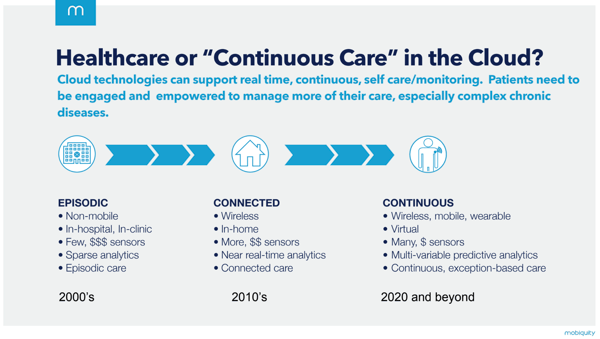Today’s continuous care landscape has healthcare professionals talking all about the cloud, wearables, internet of things (IoT), value-based care, and other new and innovative technologies. But how did we get here? Now that 2020 is upon us, let’s take a look back at how far we’ve come, and more importantly, what we can expect from this new decade.
Mobiquity’s latest infographic shows the evolution of continuous care over the last two decades, starting in the 2000’s. Let’s discuss.

Episodic in the 2000’s
In the 2000’s, healthcare was purely episodic. Patients received care only by on-site visits in the hospital or clinic, and this was largely driven by fragmented episodes of health concerns. Doctors and healthcare providers were privy to their patients’ issues only when they physically saw them. This limited access to patients caused sparse analytics, so doctors never really had a complete picture of their patients’ health.
In the 2000’s, mobile experiences were only just beginning. The first iPhone didn’t launch until 2007, nearing the end of the decade, well before mobile became a part of everyday life. (It’s hard to believe that was 13 years ago, isn’t it?) But with the iPhone’s newly afforded connections, it paved the way for the next decade and connected care was ignited.
Connected in the 2010’s
So many new technological advancements occurred in this decade. Take a look at all of these groundbreaking innovations (in healthcare and a variety of other industries):
I know this is a very odd mix of innovation, but it shows how much we’ve changed and grown, from online social interactions to incredible medical advancements and everything in between. All of this new and enhanced technology forced healthcare to follow in its footsteps and match patient experiences in the hospital and clinic to the experiences that are now standard in other aspects of human life.
This new level of connected care enabled doctors to have quicker access to their patients via patient portals, with more numerous yet less expensive sensors than the decade preceding it, producing near real-time analytics.
As the next decade approaches, we’re already seeing new trends emerge that should make huge waves in healthcare for 2020 and beyond.
Continuous in the 2020’s
Continuous care will be the theme in 2020, with wireless, mobile, wearables and the internet of healthy things (IoHT). We’ve seen this a little bit already, but the 2020’s is when we predict IoHT will make care truly continuous, without the start and stop insights that many patients and providers experience today. Gone will be the days when your doctor doesn’t know how you’re doing between visits. We foresee the next decade being one that bridges that gap.
Virtual visits and digital medical sensors have proven to lower the cost of care, providing healthcare providers with multivariable, predictive analytics, enabling diagnosis to happen before an episode ever occurs. This is another theme that we predict will takeoff in the 2020’s. Faster diagnoses for healthier patients will make the world a better place for years to come.
What predictions do you have for 2020?
This post scratches the surface on how far we’ve come in 20 years, but definitely makes the case that there is still a long way to go. Digital innovation is here to stay, and will help organizations advance their programs for years to come as technology continues to evolve. How do you plan to integrate innovation into your programs? What predictions do you have for 2020? Reach out and tell us! We’d love to hear your thoughts.
Give us your information below to start the conversation.